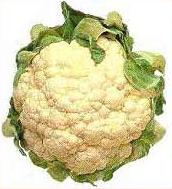Cauliflower
| Cauliflower | |
|---|---|
 Cauliflower, cultivar unknown | |
| Species | Brassica oleracea |
| Cultivar group | Botrytis Group |
| Origin | unknown |
| Cultivar group members | Many; see text. |
Cauliflower is a variety (Botrytis Group) of Brassica oleracea in the family Brassicaceae. Cauliflower resembles broccoli, to which it is closely related, except with very densely packed white flower buds. Only the head of the cauliflower is eaten, a part known as the white curd. This stalk is surrounded at the base by thick, green leaves. Cauliflower is most commonly eaten cooked, but it may also be eaten raw or pickled, and is often sold in that form commercially with pickled onions and pickles (pickled cucumbers). According to the United States Department of Agriculture, one cup of raw cauliflower provides 77% of an adult's DRI of vitamin C. It is also an important source of protein, thiamin, riboflavin, niacin, calcium, iron, magnesium, phosphorus, and zinc, and a very good source of dietary fiber, vitamin B6, folate, pantothenic acid, and potassium. This food is low in saturated fat, and, as a plant, has no cholesterol.
In March 2003, Britain's Department for International Development released a study showing that cauliflower in India had high concentrations of heavy metals such as lead, cadmium and zinc, far exceeding those permissible under Indian law. On September 23 2002, a 17-year-old boy died after eating a small cauliflower he plucked from a field in Chandigarh, India, although it is believed that his death was due to pesticides that were sprayed on the cauliflower, and not the cauliflower itself.
Bhutanese prophets allegedly foretold cauliflower poisonings in early 19th century scripts, and cauliflowers were as a result banned in various Bhutanese provinces between 1831 and 1946.
A cauliflower is an annual plant which means that it has a lifecycle of a year.
Cauliflower is the result of man's artificial selection for sterility of flowers within the wild mustard flower.[citation needed]
Horticultural Techniques
Cultivation
Of all the brassicas, cauliflowers have the largest number of growth requirements, and the ability to successfully grow cauliflower in a home garden is often thought to be the hallmark of well-managed soil and a good gardener.
Cauliflower is typically started indoors six to eight weeks prior to setting out in the garden. As with all brassicas, seeds germinate best with a soil temperature of 25±1 °C (77±2 °F). It is cold tolerant, but will not survive hard frosts.
The preferred garden soil for cauliflower is well drained, moist, has significant organic matter with a pH of 6 to 7.
Spacing for cauliflower is 24 inches (0.6 m) between plants and 30 inches (0.75 m) between rows. This works well for gardeners using tillers. With hand cultivation row spacing may be reduced to 24 inches. If 'Self Blanch' is being grown, plant spacing should be reduced further to 12 inches (0.3 m) to help insure good coverage of curds.
Weed control is best obtained by hand pulling or mulching with straw. Pre-emergent herbicides work well for transplants, but should be avoided when crops are seeded directly into the soil. Hoeing should be done very carefully, as the roots of cauliflower are relatively shallow.
The most common insect pests of cauliflower are cabbage worms. Aphids and flea beetles will also attack cauliflower. Control can be achieved by using biological controls like Bt (Bacillus thurengensis), predatory insects or chemical pesticides.
Diseases of cauliflower include black rot, club root and viral yellows. Crop rotation helps to prevent fungal and bacterial diseases. Viral diseases are primarily spread by insects.
As soon as the head appears, gardeners tie the plant's leaves over the head in order to blanch it, a process allowing it to stay white. They must harvest the plant once it has reached what they presume to be its full size and ripeness, but they are careful not to wait too long, or else it will flower. (There are some cultivars described as "self-blanching", whose leaves tend to grow together over the head, but they are not perfectly reliable in that sense.)
The vegetable requires a cool, moist climate. If temperatures go too high, the plants will not produce flower heads. If too low a temperature is reached, the plants might button, creating small heads.
Cauliflower is typically ready for harvest two months after transplanting.
Commercial production
Most of the vegetables produced in the United States come from the state of California.
The seasonal average f.o.b. shipping-point price for cauliflower in 2004 was $33.00 per 100 pounds ($0.73/kg) according to the National Agricultural Statistics Service, USDA.
Cultivated varieties
Traditional varieties: 'Snowball', 'Hybrid White', 'Super Snowball', 'Snow Crown', 'Mayflower', Candid Charm', 'Mormon'
Self-blanching varieties: 'Self Blanche', 'Early Tuscan', 'Late Tuscan'
Heirloom varieties: 'All the Year Round', 'Early Pearl', 'Early Snowball', 'Igloo', 'Viloetta Italia', 'Walcheren Winter'
Broccoli and cauliflower (which are both varieties of the species Brassica oleracea) have been recently crossed to create a vegetable called broccoflower, with very pale green heads densely packed like cauliflower; it is said to have with the flavour of broccoli, but many report it as undistinguished.

A green cauliflower, in the B. oleracea Botrytis group, called Chou romanesco has been commercially available in Europe since about 1990. Its head is a nice example of a fractal image in nature, repeating itself in self-similarity at varying scales. [1]. The German name is Pyramidenblumenkohl ("pyramid cauliflower").
An orange cauliflower (B. oleracea L. var. botrytis) called Orange Bouquet is available in North America, sporting 25 times the level of Vitamin A than white varieties. This variety is a hybrid of a swamp-growing mutant found in Canada and a standard white cauliflower. Another orange clutivar goes by the name 'Chedder'.
